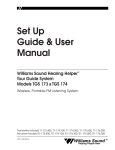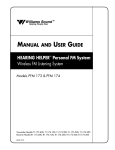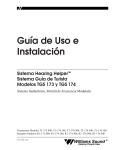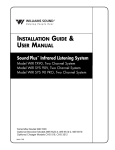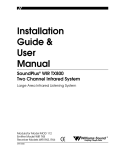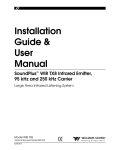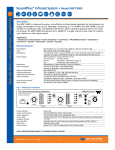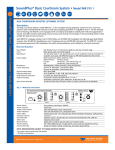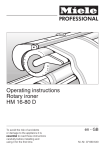Download Williams Sound WIR TX8 Installation guide
Transcript
Installation Guide & User Manual SoundPlus ® WIR TX10 Infrared Transmitter, Selectable 95 kHz or 250 kHz Carrier Large Area Infrared Listening System Modulator-Transmitter Model WIR TX10 MAN 085H ® Williams Sound Helping People Hear SOUNDPLUS ® WIR TX10 INFRARED TRANSMITTER, SELECTABLE 95 KHZ OR 250 KHZ CARRIER INSTALLATION GUIDE AND USER MANUAL Contents Page SYSTEM OVERVIEW 4 INSTALLATION PROCEDURE 6 TX10 TRANSMITTER COVERAGE PATTERNS TX10 TRANSMITTER SETUP TX10 POWER WIRING AUDIO SOURCE CONNECTION TESTING THE SYSTEM CONTROLS AND FEATURES 14 TX10 REAR PANEL TX10 BOTTOM PANEL RECEIVER INSTRUCTIONS 17 RECEIVER MANAGEMENT 17 USING MULTIPLE EMITTERS 16 TROUBLESHOOTING 18 WARRANTY 20 SPECIFICATIONS 21 NOTES: TAKING A FEW MINUTES NOW TO READ THESE INSTRUCTIONS WILL SAVE TIME AND ENSURE PROPER SYSTEM OPERATION. INFRARED RECEIVER PERFORMANCE CAN BE DEGRADED IF THIS SYSTEM IS USED IN CLOSE PROXIMITY TO HIGH-EFFICIENCY LIGHTING EQUIPMENT WITH SOLID STATE BALLASTS (I.E. HIGH EFFICIENCY FLUORESCENT) THAT OPERATE AT FREQUENCIES NEAR 95 KHZ. 250 KHZ OPERATION SHOULD BE USED WHEN THIS OCCURS. The TX10 is a CLASS 1 LED PRODUCT Williams Sound ® Helping People Hear 3 SYSTEM OVERVIEW The Williams Sound WIR TX10 Infrared Transmitter uses invisible infrared (IR) light waves to broadcast speech or music to wireless infrared receivers. The TX10 accepts a balanced or unbalanced line level audio input and emits an invisible infrared 95 kHz or 250 kHz frequency throughout the listening area. Infrared receivers detect the transmission and convert the light signals back into audio signals. The system is designed to transmit high quality audio for hearing assistance and language interpretation applications. Because the system uses infrared light for transmission, it is not affected by radio equipment and does not interfere with radio equipment. No FCC license is required. The coverage area for the TX10 will vary depending on the receiver being used. (see Figures 2 and 4 to demonstrate the receiver coverage area when operating a single TX10 transmitter in single channel mode). Generally, an RX3 receiver will operate up to 10,000 ft2 (930 m2); a RX7/8 receiver will operate up to 6,000 ft2 (560 m2); and a RX4 receiver will operate up to 4,000 ft2 (370 m2). Larger areas can be covered by connecting additional WIR TX8 Emitters. The system must be connected to an existing sound system or mixer. It does not have a direct microphone input. Infrared systems cannot be used in bright sunlight because of sunlight’s large amount of interfering infrared light. 4 Williams Sound ® Helping People Hear FIGURE 1A: TYPICAL SYSTEM CONFIGURATIONS TX10 Transmitter Baseband LED (Visible From Below) Audio Source Power On LED (Visible From Below) Amplifier 3 2 1 Power 4 5 6 7 8 9 3 2 1 10 0 Level 4 5 6 7 8 9 3 2 1 10 0 Level 4 5 6 7 8 9 3 2 1 10 0 Level 4 5 6 Line Level Output Phones 7 8 9 10 0 Level Audio Audio Limit Limit Compress Compress Audio Input Audio LED (Visible From Below) Power Supply 120 VAC (US): TFP 010 230 VAC (CE): TFP 027 FIGURE 1B: ADDING A TX8 EMITTER FOR GREATER COVERAGE AREA (SEE PAGE 16) Audio Source Amplifier 3 2 1 Power 4 5 6 0 10 Level 7 8 9 3 2 1 4 5 6 0 10 Level 7 8 9 3 2 1 4 5 6 0 10 Level 7 8 9 3 2 1 4 5 6 0 10 Level 7 8 9 Phones Audio Audio Limit Limit Compress Compress Line Level Output TX8 Emitter TX10 Transmitter Power Supply 120 VAC (US): TFP 010 230 VAC (CE): TFP 027 Baseband In Baseband Out Audio Input Power Supply 120 VAC (US): TFP 010 230 VAC (CE): TFP 027 Baseband Signal Williams Sound ® Helping People Hear 5 TX10 TRANSMITTER COVERAGE PATTERNS The coverage area for the TX10 will vary depending on the receiver being used. Figures 2 and 4 demonstrate the receiver coverage area when operating a single TX10 transmitter in single channel mode. Generally, an RX3 receiver will operate up to 10,000 ft2 (930 m2); a RX7/8 receiver will operate up to 6,000 ft2 (560 m2); and a RX4 receiver will operate up to 4,000 ft2 (370 m2). FIG 2: Receiver Coverage Area with TX8 or TX10 Transmitter in Single Channel Mode (METERS) (FEET) 27 90 24 80 21 70 18 60 15 50 12 40 9 30 6 20 3 10 0 0 -3 - 10 -6 - 20 -9 - 30 - 12 - 40 - 15 - 50 - 18 - 60 - 21 - 70 - 24 - 80 - 27 - 90 RX3 Receiver 1 Channel (Approx. 10,000 sq. feet., 930 sq. meters) RX7/8 Receiver 1 Channel (Approx. 6,000 sq. feet., 560 sq. meters) RX4 Receiver 1 Channel (Approx. 4,000 sq. feet., 370 sq. meters) 0 0 10 20 30 40 50 3 6 9 12 15 60 70 80 90 100 110 120 130 140 18 21 24 27 30 34 37 40 43 These patterns are the direct radiation pattern. The infrared radiation does not drop to zero outside the illustrated patterns; it decreases. It still may be useable at a greater distance, depending on receiver sensitivity and the reflective characteristics of the room. Reflections of the infrared light from walls, ceilings, and floors may change these patterns. Important: Remember to point the transmitter towards the listening audience! Remember: opaque objects block infrared light. Thus, transmitters cannot be concealed behind opaque walls, curtains, etc. Neither should transmitters be used in areas of extreme high or low temperatures, humidity, or chemical environments. 6 Williams Sound ® Helping People Hear FIG 3a: 3-Dimension Foot Pattern The TX10 floods the listening audience with a cone shape light pattern as shown here. The path of the cone shape light leaves a pattern on the ground, or "foot print," and indicates where the strongest receiver reception will occur. The actual coverage area will vary depending on the signal strength of the receiver being used. Refer to Figures 2 and 4 to determine how many emitters are required for 100% coverage of the listening area. To determine the best location for the transmitter, it helps to think of the IR transmitter as an invisible floodlight. You’ll want to aim it so the listeners are “flooded” with the infrared light. The transmitter should also be positioned high enough so it won’t be blocked by people and other physical obstructions. See Figure 3b below. Mount the transmitter at least 2 ft. (.61 m) above the audience. Position the transmitter to face in a slightly downward angle, 20° - that will increase the “throw” of the infrared beam. FIG 3b: Vertical Beam Spread Minimum receiver RANGE when operating with a TX8 or TX10 transmitter in Single Channel Mode. RX3 Receiver: 120' (37 m) RX7/8: 80' (24 m) RX4: 70' (21 m) (Range) TX10 er Beam f Transmitt Center O 30' SCREEN 6' STAGE Williams Sound ® Helping People Hear 7 FIG 4: Horizontal and Vertical Radiation Polar Plots Receiver Coverage Area with a TX8 or TX10 Transmitter in Single Channel Mode HORIZONTAL RADIATION POLAR PATTERNS DISTANCE FROM EMITTER TO RECEIVER 120 30 – 90 – 70 – 60 – 50 100 24 80 18 60 12 40 6 20 – 40 – 30 42 140 36 120 30 – 80 – 70 – 60 – 50 100 24 80 18 60 12 40 6 20 – 20 – 10 FEET 36 – 80 METERS 140 FEET METERS – 90 42 VERTICAL RADIATION POLAR PATTERNS DISTANCE FROM EMITTER TO RECEIVER – 40 – 30 – 20 – 10 0 0 10 10 20 20 30 30 40 40 50 50 60 90 80 60 70 90 80 70 RX3 Receiver 1 Channel (Approx. 10000 sq. feet., 930 sq. meters) RX3 Receiver 1 Channel RX7/8 Receiver 1 Channel (Approx. 6000 sq. feet., 560 sq. meters) RX7/8 Receiver 1 Channel RX4 Receiver 1 Channel (Approx. 4000 sq. feet., 370 sq. meters) RX4 Receiver 1 Channel Reflections of the infrared light from walls, ceilings, and floors may change these patterns. Important: Remember to point the transmitter towards the listening audience! If you’re not getting sufficient coverage with a single, properly installed TX10 Transmitter, you’ll need to add WIR TX8 Emitters to achieve full coverage of your listening area (see page 16, Using Multiple Emitters). Figures 5a and 5b illustrate how multiple emitters can be used for large room installations. 8 Williams Sound ® Helping People Hear Multiple Transmitters Installed to Maximize Coverage FIG. 5a: Overlapping Illumination Patterms to Cover Larger Listening Areas TX10 TX8 TX8 TX8 Fig. 5a above is a typical example of how multiple transmitters are used to cover larger listening areas. Generally, it is desirable for the illumination patterns to overlap. Note: The coverage area will vary depending on the infrared receiver being used; refer to Figures 2 and 4 to determine how many transmitters are required to achieve full coverage of a listening area. FIG. 5b: Using Two Transmitters at Same Emission Point to Increase Coverage Area TX10 TX8 Coverage area with Single Transmitter Coverage area with Second Emitter Added to Same Emission Point (50% increase) When two transmitters are used at the same emmission point in single channel mode, the overall coverage area increases 50%. When using an RX3 receiver, as a result, the coverage area will increase to 15,000 ft2 (1,393 m2); the RX7/8 will increase to 9,000 ft2 (836 m2); and the RX4 will increase to 6,000 ft2 (557 m2). Williams Sound ® Helping People Hear 9 INSTALLATION PROCEDURE The TX10 Infrared Transmitter should not be installed outdoors, or where there is a lot of direct sunlight indoors. Sunlight generates infrared interference. Certain types of high-efficiency lighting fixtures can also generate interference at 95 kHz because they use high frequency modulation. FIG. 6: BRACKET 024 MOUNTING TX10 Emitter Swivel Head Shaft (optional) Shaft Plate Cover Mounting Plate (To Wall or Ceiling) tension screw Mounting Screws INSTALLATION STEP 1: MOUNTING THE TX10 TO A WALL OR CEILING Step 1: Using the mounting plate (Figure 6) as a template, mark the hole locations on the mounting surface where the TX10 will be installed. See Figure 7 below for optional mounting positions. Step 2: Locate the top mounting hole in the rear of the TX10 transmitter. Gently screw the male end of the swivel head on to the transmitter. Tighten the swivel head tension screw: turn clockwise until the connection is secure. Step 3: Screw the male end of the shaft into the female end of the swivel head. An additional shaft can be added to create more distance between the wall/ceiling and Transmitter. Step 4: Place the plate cover snugly over the mounting plate. This will hide the screws after installation. Step 5: Screw the male end of the mounting plate into the female end of the shaft. For suspended ceilings, screw the female end of the shaft into the male end of the T-Bar clip. The mounting bracket is now installed on to the TX10 Transmitter. Step 6: Position the TX10 Transmitter and BKT 024 so the mounting plate lines up with the marked holes on the mounting surface. Fasten the mounting plate to the surface using screws and wall anchors. Mounting the TX10 to a Suspended Ceiling with Cross Tee: Fasten the T-Bar clip on to the desired Cross Tee. Step 7: Position the TX10 Transmitter to the desired angle: Begin by gently turning the tension screw (Figure 6) counter clockwise to release the swivel head. Adjust the TX10 to the desired angle. When the TX10 is in the desired position, gently turn the tension screw clockwise until the swivel head is securely in place. FIG. 7: WALL OR CEILING MOUNT Figure 7a: Mounting the TX10 on to a wall with the BKT 024. Tip: To keep the TX10 level, rotate the tension screw (Fig. 6) so it rests on top of the bracket. Figure 7b: Mounting the TX10 on to a ceiling with the BKT 024. 10 Williams Sound ® Helping People Hear INSTALLATION STEP 2: TX10 TRANSMITTER POWER WIRING POWER SUPPLY FOR THE TX10 The TX10 must be supplied power from a Limited Power Source as defined by EN 60950:1992; Clause 2.11. Units operated from 120 VAC must use Williams Sound part number TFP 010. Units operating from 230 VAC must use Williams Sound power supply part number TFP 027/UK. WARNING: POWERLINE VOLTAGE MUST NOT FALL BELOW 94V, OR SYSTEM PERFORMANCE WILL BE GREATLY REDUCED! FOR U.S. APPLICATIONS: The TX10 Transmitter is supplied with a low-voltage wall transformer power supply (TFP 010). Two-conductor 18 ga. power cord is included with the transmitter. FOR APPLICATIONS OUTSIDE THE U.S. REQUIRING 230 VAC MAINS SUPPLY: Use the transformer power supply, model TFP 027/UK. Secondary Specifications: 24 VAC, 35 VA, 50/60 Hz. DO NOT CONNECT THE POWER SUPPLY TO AC POWER YET!!! Step 1: Determine the length of power cord needed to reach from the transmitter to the AC wall outlet where the power supply will be plugged in. If power cord length will exceed 200 feet (61 m), heavier gauge wire will be required. Use the table below. Make sure the power supply is not plugged into AC power yet! Cable Length Required Up to 10 feet (3 m) Up to 75 feet (23 m) Up to 200 feet (61 m) Up to 500 feet (152 m) Up to 1,000 feet (305 m) Minimum Wire Gauge 22 gauge 20 gauge 18 gauge 16 gauge 14 gauge One end of the power cord has a 3-pin Molex connector, the other end is bare. Cut the bare end of the power cord to length. Strip this end down the middle approximately 1 inch, then strip both of the resulting strands about 1/8 inch. Install the crimp-on spade terminals supplied and connect these to the screw terminals on the power supply (TFP 010). Polarity is not important since AC power is being used. Step 2: Plug the 3-pin Molex connector into the TX10’s Power In connector. Step 4: Plug in the Power Supply last. The Power Indicator LED on the right side of the bottom panel (visible from directly underneath) glows when the TX10 is on. The TX10 transmits when an audio signal is present, and will shut off when no signal is present for about 30 minutes. This auto shut-off feature preserves the life of the infrared LEDs and reduces power consumption. Note: This system is designed for Class 2, low-voltage wiring. Always follow local electrical codes when doing low voltage wiring. Williams Sound ® Helping People Hear 11 INSTALLATION STEP 3: AUDIO SOURCE CONNECTION The WIR TX10 accepts audio signals from balanced or unbalanced line level outputs, transmitting audio with excellent fidelity. Therefore, be sure to connect its input to the highest quality audio source your system can offer. Step 1: Determine the length of cable needed to reach from the audio source to the TX10 Transmitter. You will need to cut it to length. Make sure you leave some slack at each end. Step 2: Prepare the cable for an unbalanced or balanced connection. (See Figure 8a.) Step 3: Connect the audio cable to the Audio Input terminals using Figure 8b as a guide. FIGURE 8A: CONNECTING THE TX10 TO AN AUDIO SOURCE In Phase To TX10 To TX10 Unbalanced Line Using 1/4" Connector Balanced Line Using 1/4' Connector In Phase To TX10 To TX10 1 3 Pin Connector 1 2 2 3 3 3 Pin Connector Unbalanced Line Using 3–Pin Connector Balanced Line Using 3–Pin Connector FIGURE 8B: CONNECTING AN AUDIO SOURCE TO THE TX10 Signal POS NEG GND + – G POS Shield Jumper Unbalanced 12 + NEG – G GND Signal Signal Shield Balanced Williams Sound ® Helping People Hear INSTALLATION STEP 4: TESTING THE SYSTEM Step 1: After the power cable and audio source are connected, the Power LED indicator on the right side of the the bottom panel should light. Step 2: Make sure the sound system is on and your audio source is active. Turn the Audio Input Adjust if necessary. (See Figure 9.) Step 3: Look at the TX10's bottom panel. With the input signal present and power connected, three lights should be visible from directly underneath the panel: the red Power LED, the amber Audio LED indicator, and the green Baseband LED. At normal levels, the Audio LED should flash intermittently. FIGURE 9: WIR TX10 CONTROLS (ACCESSIBLE THROUGH VENT HOLES) Audio LED [amber] Flashes to indicate audio signal Baseband LED [green] Indicates presence of baseband signal Power LED [red] Indicates transmitter is on when lit. FRONT BACK Audio Input Adjust Controls level of audio signal Frequency Switch Selects between carrier frequencies 95 kHz 250 kHz If the Audio LED does not flash at all, increase the audio level by turning the Audio Input Adjust (accessible through the vent holes) with a small screwdriver or similar tool. If the Audio LED is lit constantly, decrease the Audio Input Adjust. The baseband and Baseband Indicator will shut off after the audio signal has been absent approximately 30 minutes. If the Baseband LED is not on, check your audio source. Step 4: Take a receiver into the listening area and walk around to check the reception. Make sure the transmitter and receivers are set to the same frequency. Make sure the “eye” on the receiver is not covered up when in use. The receiver will not work if it is placed in a pocket or purse; its eye must be able to “see” the transmitter panel. A WIRM-1 Infrared Field Strength Meter may be used to check signal strength if the TX-10 is operating on 95 kHz. It may be necessary to adjust the angle of the transmitter to obtain the best coverage. If coverage is not adequate, add one or more WIR TX8 Emitter panels to the system. (See page 16, Using Multiple Emitters) If the Audio LED is on, the Baseband LED is flashing, but you don’t hear anything from the receiver, try a different receiver to be sure the receiver is not at fault. Williams Sound ® Helping People Hear 13 CONTROLS AND FEATURES WIR TX10 REAR PANEL POWER IN 21 VAC to 26 VAC only, 50 or 60 Hz (120 VAC [US]: TFP 010 Power Supply / 230 VAC [CE]: TFP 027 Power Supply). Consumption is 35 VA. AUDIO INPUT The WIR TX10's input circuit is constructed with a differential amplifier, providing better performance than that available using a transformer. It is fully protected from RFI/EMI. Both balanced and unbalanced line level signals can be accommodated. The minimum acceptable level is approximately 100 mV, and the maximum level before clipping is approximately 10 V. 25 V, 70 V, and 100 V speaker distribution lines can be connected to the Line input using attenuator made with resistors or with speaker-matching transformers. Resistor attenuator yield better results. Design the attenuator to deliver about 1 V of audio to the input of the TX10. BASEBAND OUT A carrier tone of either 95 kHz or 250 kHz is provided at this BNC connector. One 50 Ω device may be connected here using RG-58 cable. Additional devices may be connected by FIGURE 10: WIR TX10 REAR PANEL Williams Sound ® Helping People Hear WIR TX10 Multi-Channel Infrared Transmitter CAUTION RISK OF ELECTRIC SHOCK DO NOT OPEN WARNING: TO REDUCE THE RISK OF FIRE OR Class I ELECTRIC SHOCK DO NOT EXPOSE THIS Made in U.S.A. LED Product EQUIPMENT TO RAIN OR MOISTURE. Note: It is normal for this unit to feel warm while it is in operation. Audio Input Mounting Template Line Level, Bal. or Unbal POS Power Supply Wiring: NEG For up to 200 ft. (61m): Use NEC, Class 2 Wiring, 18 ga. For lengths greater than 200 ft. (61m), see the manual. GND + – G Signal Signal Shield Balanced Signal + – G Williams Sound Corp., Minneapolis, Minnesota, USA Shield Jumper Unbalanced Power In: 24VAC 50-60Hz 35VA NC Plug C Baseband Out (Modulation) 24 Baseband LED Power LED 50 Ohms Audio Input Adjust Audio LED 250kHz 95kHz Power Connection 120 VAC (US): TFP 010 230 VAC (CE): TFP 027 14 BKT 012 Wall/Ceiling Mount Template Set of threaded holes for use with omnidirectional mount. Audio Input Terminal block, accepts line level, balanced or unbalanced inputs Baseband Out BNC Connector, 50 Ω, 50 kHz–1 MHz Baseband ®® Williams Williams Sound Sound Helping HelpingPeople PeopleHear Hear “looping through” the connected device or by means of a suitable distribution amplifier. The output impedance is 50 Ω. Frequency accuracy is better than ± .010%. Deviation is ± 50 kHz, maximum. WIR TX10 BOTTOM PANEL POWER LED Indicates actual operation of the transmitter. Does not indicate status of power supply. FREQUENCY SWITCH This slide switch selects between carrier frequencies of 95 kHz and 250 kHz. Accessed through holes in chassis bottom. AUDIO INPUT ADJUST Controls level of audio signal. The control is connected between the input amplifier and the audio level processing circuit. Accessed through holes in chassis bottom. AUDIO LED Flashes to indicate audio signal level. When Audio Input Adjust is set correctly and volume is normal, the LED should flash intermittently. BASEBAND LED Lights when audio signal is present. FIGURE 11: WIR TX10 BOTTOM PANEL Audio LED Flashes to indicate audio signal Baseband LED Indicates presence of baseband signal Power LED Indicates transmitter is on when lit. FRONT BACK Audio Input Adjust Controls level of audio signal Frequency Switch Selects between carrier frequencies 95 kHz 250 kHz Williams Sound ® Helping People Hear 15 USING MULTIPLE EMITTERS Listening areas of more than 10,000 square feet (930 square meters) will require a TX10 and at least one TX8 Emitter for complete coverage. Place one TX10 transmitter on the left side of the front wall and one TX8 emitter on the right hand side. For extremely large venue, additional TX8s should be located to maximize coverage throughout the listening area. Figures 5a and 5b illustrate infrared light patterns and recommended emitter locations. A WIRM-1 Infrared Field Strength Meter may be used to check signal strength if the TX-10 is operating on 95 kHz. Step 1: Determine the length of coaxial cable needed to reach between the emitters. 100 feet (30 m) of coaxial cable is included with each emitter. You will need to cut it to length. Additional RG–58 coax can be added. Make sure you leave some slack at each end. Step 2: Install BNC connectors on each end of the cable. (See Figure 13.) Step 3: Connect the baseband cable from the Baseband Out jack on the TX10 Transmitter to the Baseband In jack on the first TX8 emitter in the chain. Use the cable clamps and screws provided to secure the cable. The coax can also be routed through conduit before attaching BNC connectors. You can chain as many emitters together as you need. Remember that each emitter needs its own power supply. FIGURE 12: WIRING DETAIL, MULTIPLE EMITTERS Audio Source Amplifier Phones Power Level Level Level Level Audio Audio Compress Compress Line Level Output TX10 Transmitter TX8 Emitter Baseband In Baseband Out Audio In To Additional TX8 Transmitters Baseband Out Power Supply 120 VAC (US): TFP 010 230 VAC (CE): TFP 027 Power Supply 120 VAC (US): TFP 010 230 VAC (CE): TFP 027 RECEIVER INSTRUCTIONS (OPTIONAL) 16 Williams Sound ® Helping People Hear IR RECEIVER MODELS WIR RX3, WIR RX7, WIR RX8 Make sure the “eye” on the front of the receiver is not covered up when in use. The receiver is intended to be worn on the front of the body, hanging from the lanyard attached to the receiver. The receiver will not work if it is placed in a pocket or purse. A variety of earphones, headphones, or neckloop telecoil couplers can be used with RX3, RX7 and RX8 Receivers. Step 1: To install batteries in the RX7, or RX8, open the battery compartment using a coin in the slot in the bottom of the receiver. Press two AA batteries into place, observing proper battery polarity. Step 2: Plug the earphone or headphone into the earphone jack. Step 3: Turn the receiver on by rotating the volume control knob clockwise. Step 4: Adjust the tone to your preference using the slide switch tone control. (Not on the RX3 or RX4) To avoid draining the battery, make sure the receiver is turned off when not in use. BATTERY INFORMATION For RX7, or RX8 Receivers in normal use, two AA alkaline batteries (BAT 001) will last about 30 hours. Rechargeable AA batteries (BAT 026) will last about 15 hours per charge. (The RX3 uses a 9V battery.) If you are using BAT 026 rechargeable batteries, use the CHG 200A Multi-Charger. Contact your dealer or Williams Sound for details. If the sound becomes weak or distorted, replace the batteries. The indicator light may still be on, even with weak batteries. Do not leave dead batteries in the receiver, they may leak and damage the receiver. RECEIVER MANAGEMENT Different types of facilities will use different approaches for receiver management and earphone sanitation. Below are some options that customers have used successfully. Regular users purchase their own receiver and take care of their own batteries and earphone. Some facilities label the receiver and earphone with the names of regular users so each person uses the same receiver and earphone. Ushers issue receivers to people who request them. Earphones are sanitized after use. Foam ear cushions can be replaced or washed with a mild detergent, rinsed thoroughly and air-dried. The EAR 022 Surround Earphone can be sanitized with an alcohol pad. The receivers can be stored in a multiple compartment storage case with a credit card or driver's license left as collateral for the receiver. !! IMPORTANT WARNINGS !! DO NOT ATTEMPT TO RECHARGE ZINC CARBON (“HEAVY DUTY”), ALKALINE, OR LITHIUM BATTERIES! DO NOT ATTEMPT TO RECHARGE DISPOSABLE BATTERIES! These batteries may heat up and explode, causing possible injury and damage to the equipment. Avoid shorting the plus and minus battery terminals together with metal objects. Battery damage and burns can result! Use only Williams Sound supplied charger and batteries! Williams Sound ® Helping People Hear 17 Regular users purchase their own earphone or headphone and bring them to use with receivers at the facility. Some facilities use the drop-in style CHG 200 or CHG 1269 Multi-charger for both storing and charging receivers TROUBLESHOOTING NO INDICATOR LIGHTS ARE ON (FIG 9). Make sure the wall transformer is plugged into the transmitter and the power switch or any remote power switch is on. Make sure the electrical outlet is on. Make sure the 24 VAC power supply is working. ONLY ONE INDICATOR LED (RIGHT) COMES ON (FIG 9). Make sure an audio signal is being sent to the WIR TX10. NO SOUND THROUGH RECEIVERS. If some of the receivers work but others don’t, check for bad batteries or earphones on the receivers that aren’t working. If none of the receivers work, check to see if the power and audio are connected to the transmitter and that the Power and Audio LEDs are ON. Check to see if the TX10 is connected properly to the sound system. The Audio LED should flash intermittently. If it does not light, turn the Audio Level Adjust with a small screwdriver or similar tool. The Audio Level Adjust is accessible through the TX10's bottom panel vent holes. Make sure the “eye” is not covered up on the receiver. There must be clear line of sight between the receiver eye and the transmitter panel. Make sure the selected modulator frequency matches the selected receiver frequency. SOUND THROUGH THE RECEIVERS IS WEAK AND NOISY. Try increasing the input signal level from the sound system by turning up a mixer control. If this does not help, you need to re-position the transmitter panels or add additional panels. NOTE: Make sure the powerline voltage does not fall below 94V or system performance will be greatly reduced! BUZZING OR HUMMING NOISE IN SOUND SYSTEM. 18 Check for ground loops or noise on the input signal. Call your Authorized Dealer or Williams Sound for help. Williams Sound ® Helping People Hear 13B FIGURE 13: BNC CONNECTOR ASSEMBLY Washer 7.92 mm (± .25) .312 in. (± .01) Grooved Side Nut Gasket (note groove) Nut Cable Jacket Washer Plug Assembly Gasket 13C Clamp Contact Clamp positioned against Cable Jacket ASSEMBLY PROCEDURE 13D The BNC Connector consists of a plug assembly, a contact, a clamp, a gasket, a washer, and a nut. 1. Slide nut, washer and gasket over cable end; then strip outer cable jacket using the recommended strip-length dimension in figure 13b. Clamp Collar Clamp Braid folded over Clamp and trimmed 13E 2. Slide clamp over cable braid and position it against the cable jacket. After clamp is properly positioned, comb out the braid. 3. Fold cable braid over the clamp and trim it so that it is positioned against the clamp collar. See figures 13c and 13d. 3.96 mm (± .25) .156 in. (± .01) Dielectric 13F 4. Using the dimension in figure 13e, strip dielectric to expose the center conductor. If applicable, tin the center conductor. 5. Solder contact to the conductor (using standard soldering techniques), making sure contact is bottomed on cable dielectric. See figure 13f. Dielectric Contact soldered to conductor and bottomed on dielectric 13G Gasket (Ref.) DO NOT allow a hot soldering iron to touch cable dielectric. Certain cable dielectric materials, such as polypropylene, will expand if they come in contact with a hot soldering iron. 6. Insert contact into plug assemble until contact snaps into place. See figure 13g. 7. Thread nut into plug assembly until it is secured. Recommended cable clamp tightening torque is 2.8–3.4 N•m [25-30 in.-lb.], using a 7/16" wrench. See figure13h. Williams Sound ® Helping People Hear Contact Assembly inserted into Plug Assembly Plug Assembly 13H 50 Ω BNC Plug Connector Nut Secured Into Plug Assembly 19 Warranty The Williams Sound WIR TX10 Infrared Transmitter is engineered and designed to provide you with many years of reliable service. Williams Sound warrants against defects in materials and workmanship for FIVE (5) years EXCEPT FOR earphones, headphones, rechargeable batteries, charger, cables, antennas, carry cases, and all other accessory products. Accessory products carry a 90 day warranty. If the product fails within the specified warranty period, Williams Sound will determine whether to repair or replace the defective equipment. This warranty does not apply to physical damage, abuse, mis-use, or products that have been modified. This warranty does not apply to damage caused by attempting to charge non-rechargeable batteries. If you experience difficulty with your system, call for Customer Assistance: 1-800-328-6190. If it is necessary to return the system for service, a Williams Sound representative will give you a Return Authorization Number (RA) and shipping instructions. Pack the system carefully and send it to: Williams Sound Corp. 10321 West 70th Street Eden Prairie, MN 55344-3459 USA Phone: 800-843-3544 952-943-2252 Fax: 952-943-2174 TTY: 952-943-9675 e-mail: [email protected] Canadian Customers Please contact: European Customers Please contact: Thorvin Electronics 2861 Sherwood Hgts Dr Units 36-37 Oakville, ON L6J-7K1 Canada Phone: 905-829-3040 Phone: 800-323-6634 Fax: 905-829-4196 email: [email protected] Doreen Armstrong Urb. Los Naranjos de Marbella Fase 2 Apartamento 7 29660 Nueva Andalucia, Marbella SPAIN Phone: (34) 952 819 069 Fax: (34) 952 819 201 email: [email protected] Your warranty becomes effective the date you purchase your system. Your returned warranty card is our way of knowing when your warranty begins. It also gives us important information about your system including the serial number. This information will help us serve you better in the future. Please take a moment to complete and mail the attached card. Thank you. 20 Williams Sound ® Helping People Hear SoundPlus® WIR TX10 Infrared Transmitter Specifications INFRARED TRANSMITTER, MODEL TX10 Dimensions, Weight: 11.25" W x 6.25" H x 2.125" D (28.6 cm x 15.9 cm x 5.4 cm) 1.9 lbs. (0.9 kg) Color: Black anodize with white legends, red acrylic window Wall Mount: BKT 024 mounting bracket included for wall and ceiling mounting. Tripod Mount: Optional SS-6 Tripod Stand Kit available Operating Req.: 0-50° C (32-106° F) ambient temperature, non-condensing, non-corrosive atmosphere Frequency: 95 kHz or 250 kHz; ± 50 kHz deviation, 50 µsec pre-emphasis Power Requirements: 24 VAC; 50-60 Hz; Supplied by TFP 010 (120 VAC) or TFP 027/UK (230 VAC Input) Signal to Noise Ratio: 55 dB Audio Frequency Response: 50 – 15,000 Hz, +1, –3 dB Coverage Area: RX3 Receiver: 10,000 ft2 (930 m2); RX7/8 Receiver: 6,000 ft2 (560 m2); RX4 Receiver: 4,000 ft2 (370m2) 50° cone pattern; For larger areas, connect add’l WIR TX8 Emitters Carrier Timer: One 30 minute (approx.) timer. Turns off TX10 if audio signal is absent for 30 minutes Infrared LEDs: 120 Infrared Type: Class 1 LED Product REAR PANEL: Mounting Holes: Line Level Input: One set of threaded holes for use with the BKT 024 mounting bracket (included); Two threaded holes on sides of the cabinet for Tripod Stand Kit Terminal block, accepts unbalanced or balanced line level inputs Baseband Output: BNC connector, 50 Ω Baseband Cable: RG-58 Coax, BNC-connectors Power: External power supply, 3-pin molex connector, 24 VAC, 50 or 60 Hz, 35 VA, 0.9 A nom. current drain Power Cable: NEC Class 2 wiring, 2-conductor, 18 ga.; 200 foot (61 m) max. length for 18 gauge wire (See table below for minimum gauge requirements at other lengths) Each TX10 Transmitter requires its own 24 VAC Power Supply Cable Length Required Up to 10 feet (3 m) Up to 75 feet (23 m) Up to 200 feet (61 m) Up to 500 feet (152 m) Up to 1,000 feet (305 m) Minimum Wire Gauge 22 gauge 20 gauge 18 gauge 16 gauge 14 gauge BOTTOM PANEL: Power LED: Red LED, visible from bottom through vent holes, right side Baseband LED: Green LED, visible from bottom through vent holes, center Audio LED: Amber LED, visible from bottom through vent holes, left side Frequency Selector Switch: Slide-type, selects between 95 kHz or 250 kHz Audio Input Adjust: Controls audio input level, screwdriver-adjust Warranty: Five Years, Parts and Labor. 90 days on cords, earphones, headphones, batteries and other accessories NOTE: SPECIFICATIONS SUBJECT TO CHANGE WITHOUT NOTICE. Infrared receiver performance can be degraded if this system is used in close proximity to highefficiency lighting equipment with solid state ballasts (i.e. high efficiency fluorescent) that operate at frequencies with harmonics near 95 kHz. 250 kHz operation should be used when this occurs. POWER SUPPLY FOR THE TX10 The TX10 must be supplied power from a Limited Power Source as defined by EN 60950:1992; Clause 2.11. Units operated from 120 VAC must use Williams Sound part number TFP 010. Units operating from 230 VAC must use Williams Sound systems part number TFP 027/UK. Williams Sound ® Helping People Hear 21 INFRARED RECEIVERS, MODELS WIR RX7 & WIR RX8 (OPTIONAL) Size and Weight: Color and Material: Battery Type: Battery Life: Modulation Frequency: Signal to Noise Ratio: Controls: Audio Output: Acoustic Output: 3-5/8" L x 2-3/8" W x 7/8" H (9.2 cm x 6 cm x 2.4 cm) 4.48 oz. (127 g) Grey, shatter-proof polypropylene 1.5V (AA) x 2, Alkaline (BAT 001) or Rechargeable AA NiMH (BAT 026) 30 hours with BAT 001, 15 hours/charge with BAT 026, 25 mA, nom. current drain RX7: 250 kHz FM, 50 µS de-emphasis; RX8: 95 kHz FM, 50 µS de-emphasis 60 dB Combination volume/On-Off knob, Switched Low-Cut tone control (Lo: 20 Hz / Mid: 120 Hz / Hi: 700 Hz) 3.5 mm mono mini phone jack, 35 mW maximum into 16 Ω 130 dB MAX SSPL90 with EAR 013 Note: The RX7/RX8 Infrared Receivers can be used with a Neckloop TeleCoil Coupler (NKL 001) to magnetically couple into a hearing aid that has a telephone pick-up coil. Add’l Compatible Receivers: WIR RX3: Single Channel Infrared Receiver, operates at 95 kHz WIR RX4: Single Channel Infrared Receiver, operates at 95 kHz Warranty: Five Years, Parts and Labor. 90 days on cords, earphones, headphones, batteries and other accessories NOTE: SPECIFICATIONS SUBJECT TO CHANGE WITHOUT NOTICE. Infrared receiver performance can be degraded if this system is used in close proximity to high-efficiency lighting equipment with solid state ballasts (i.e. high efficiency fluorescent) that operate at frequencies with harmonics near 95 kHz. 250 kHz operation should be used when this occurs. 22 Williams Sound ® Helping People Hear RECYCLING INSTRUCTIONS BATTERY SAFETY AND DISPOSAL Help Williams Sound protect the environment! Please take the time to dispose of your equipment properly. Product Recycling for Customers in the European Union: Please do NOT dispose of your Williams Sound equipment in the household trash. Please take the equipment to a electronics recycling center; OR return the product to the factory for proper disposal. Battery Recycling for Customers in the European Union: Please do NOT dispose of used batteries in the household trash. Please take the batteries to a retail or community collection point for recycling. 12/07/05 Williams Sound ® Helping People Hear 23 Williams Sound Corp. 10321 West 70th St., Eden Prairie, MN 55344-3459 U.S.A. 800-328-6190 / 952-943-2252 / FAX: 952-943-2174 24 www.williamssound.com © 2005, Williams Sound Corp. MAN 085H
























